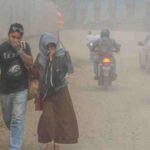Weekly The Generation, Year 1, Issue 17
December 26, 2023
The JN.1 COVID variant descends from the omicron family substrain BA.2.86, or Pirola, which hit the U.S. this summer. First detected in the U.S. in September, JN.1 has been recorded in 12 countries including Canada, France, the U.K., Singapore, and Sweden. Canada, Last week, China reported seven JN.1 infections, Reuters reported.
Wearing masks, ventilating rooms, current tests, vaccines and treatments “still work well against JN.1,” the CDC said Dec. 22. “At this time, the spread of JN.1 does not appear to pose additional risks to public health beyond that of other recent variants. CDC is closely monitoring COVID-19 increases domestically and internationally and will communicate if the situation changes.” New and ongoing COVID hospital admissions, COVID diagnoses in emergency rooms, and the percentage of test results positive for COVID, have risen steadily since November through the week ending Dec. 16. But they remain below that seen in the wake of and during the pandemic, according to the CDC.
This follows a pattern of COVID-19 rising to a peak in late summer, slowing and then peaking again around the new year. “Right now, we do not know to what extent JN.1 may be contributing to these increases or possible increases through the rest of December like those seen in previous years,” the agency said.
Deaths due to COVID have fallen slightly, but that could be because cause of death statistics can lag behind other results.
What are the JN.1 COVID variant symptoms?
Symptoms of COVID-19 infection as a result of JN.1 remain similar to that from other variants, the CDC says. They may include:
Fever or chills.
Cough.
Sore throat.
Congestion or runny nose.
Headache.
Muscle aches.
Difficulty breathing.
Fatigue.
New loss of taste or smell.
“Brain fog” (feeling less wakeful and aware).
Gastrointestinal symptoms (upset stomach, mild diarrhea, vomiting).
Source: USA Today







